When we received our Gold Rights Respecting Schools banner we had to take down our silver one. We wondered what we could do with the old banner. We decided to repurpose it into a giant paint easel outside!
Doesn’t it look great!
We decided we would love a mascot to show that we are a Rights Respecting School.
We had a competition and every child had the opportunity to design a mascot. We selected 4 favourites and voted to decide which design would become our mascot.
The runners up-
The winning design-
The winning design was Mr Crocodile and we got him made into a cuddly toy. Doesn’t he look great. Well done to Leo for producing the winning design. 
Just in case you don’t know, we have a large crocodile lurking in our wooded area of the garden. He was rescued from our old building after a public campaign led by one of our families so Mr Crocodile is perfect!
By Mr Fleming
We have been learning about our bodies. We know how to keep ourselves healthy. We are very interested in what is inside our bodies. We have learned we have a skeleton and are learning the names of some of the bones. We worked together to make our own skeleton.
“ There are lots of ribs.”
“ The spine is long.”
There are little bones in your toes.”
In Glenwood, we celebrate what is special and unique about each and every person. We are all loved and included just for being who we are!

We had a special Being Me! celebration and invited all our families. We performed some of our favourite songs using Makaton signs. Our songs included our Rights song as we learn all about the rights of all children.
Together with our families we decorated wooden hearts to celebrate what is special and unique about us and to share some of things that are important to us.


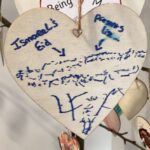






Happy Diwali to our families and friends celebrating this week.
Diwali is the five-day Festival of Lights, celebrated by millions of Hindus, Sikhs and Jains across the world.
Diwali is a festival of new beginnings and the triumph of good over evil and light over darkness, and for some also coincides with harvest and new year celebrations.
One of the ways people celebrate Diwali is by decorating their homes with colourful rangoli designs, lighting diyas or displaying lights around the house.
We have been learning about Diwali through stories, research and activities.
We painted colourful rangoli designs to decorate our nursery.
We created clay diya lights and painted these in bright colours.
Happy Diwali!
by Mrs Allison
After reading ‘Room on the Broom’ the children decided they would like to make their own Halloween potions. We used lots of natural ingredients like pumpkin seeds and pulp, herbs, spices and petals.
We had a few horrible ingredients too like Goblin snot and Giant’s toenails. The children used lots of different utensils to measure, stir, pour and mix our ingredients.
There was lots of great descriptive language being used when talking about our potions and the children came up with some brilliant names:
“Unicorn in a bush”
“Dragon fire”
“Stinky Slime”
Afterwards some of the children used their mark making skills to make potion recipe books.
by Miss McArthur
Do you have an old sheet lying around?
Do you have some empty spray bottles and/or paintbrushes?
If you do, then this activity might be the one for you!
You can help your child develop their big, gross motor muscles and their small, fine motor skills through painting on a large white sheet.
In this activity, the children were using varying brush sizes to accomplish the “splat” look! They have been developing their gross motor skills through using their shoulders, arms and wrists to splat with the brushes and they challenged each other to see who could splat the furthest.


The children have also been developing their fine motor skills through the use of spray bottles. The children are manipulating the nozzle and using their knowledge of direction to ensure that they spray the sheet.




Did you know?
One of the most important skills developed through art activities is fine motor development. During art experiences, your child’s small muscles in their fingers, hands, and wrists are exercised and strengthened, helping to make learning to write easier!
Ideas to develop your child’s fine and gross motor skills at home:
● Spray bottles with paint or water- your child can spray a sheet to decorate it or spray the flowers to help care for them!
● Paint brushes- a variety of sizes are perfect to develop your child’s fine motor and pincer skills! Helpful hint- larger handles can be useful for younger children i.e. siblings under 3 as they will be able to grip the handle better!
● Chalking outdoors.
● Painting on large areas such as sheets or A3 paper will encourage children to use their bigger muscles in their shoulders and arms.
Painting and creating with your child, not only helps their creative development but it also stimulates their brain. They can also learn about colour mixing and colour recognition through art activities. Painting doesn’t always have to be sitting at the table with a paintbrush and paint, the opportunities are limitless; be creative and offer it to your child in a variety of ways, like large-scale painting, cling film on windows, window paints, and stone painting (to name a few!) Painting opportunities are great for developing your child’s social skills and their communication as they learn new terms, words and phrases and talk aloud about their thoughts and processes. We would love to see some Tweets of the art activities your child has taken part in at home.
by Mrs Burnett
November has provided so many opportunities for quality conversations with the children and helped nurture a love of inquiry and investigation.
After the excitement of Halloween, the children were talking about scary things they had associated with having been out guising. Vampires and bats were a recurring theme, which some children seemed genuinely worried about, so we explored a little about bats to dispel the myths about them being scary.
“They drink your blood.”
“Bats are scary…but not Batman. I like him.”
“I don’t like them, they frighten me.”
Investigation
We talked about how we could find out more information on bats and discovered we could ask people to see what they know, we could look up books in the nursery and we could look on the computer to help us.


We considered what we wanted to know about bats, which included what they eat… particularly do they drink people’s blood at Halloween, but also where they live, where they sleep and what do baby bats look like?
Children naturally have inquiring minds and researching together further develops an interest in discovery. It also reinforces that it is ok not to know something because we can all learn something new.


We discovered that bats are not so scary after all…even vampire bats because “they don’t live in Scotland.” The children particularly liked the pictures of the Natterer’s Bat which they nicknamed “the laughing bat” because “he is smiling” in the photos. We learned that many of the species of bat we have in Scotland are tiny and most weigh less than a £1 coin, which felt very light when we held the coin in our hands. We even found out what bat poop looks like!
Development
We learned online that you can make your own bat box .
“It’s a bit like a bird house.”
Some of the children drew pictures of the bat they wanted to make a house for and even drew a design for a bat box.
With the help of a social enterprise that specialises in recycling wood, we sourced a bat box that the children helped assemble using the tool bench. One of the children even tested it out for size using a dinosaur!

Our bat box is ready for the spring when the bats come out of hibernation and everyone now agrees that bats are not scary any more.
by Mrs Cramb
Small world play is when children use figures and resources in miniature to build stories and play imaginatively. Your small world could represent a real-life place like a farm, zoo, nursery, home or it might be a completely imaginary world.
Small world play offers a fantastic opportunity to grow a child’s imagination and is also an outlet for their emotions. Children can do everything from acting out routines or recalling past events, to building their own unique stories.
When observing the children, l noticed that they were using their imagination to pretend that they were superheroes. I asked the children if they would like to create their own superhero small world. They decided they wanted to create a small world for some of our superhero peg people. The children selected an empty box from the junk modelling and recycled it into an amazing building for our superheroes to explore.
The children chose the colours to paint their box and used different patterned rollers, which gave the outside of their box some texture. They added some small stones, twigs, logs and leaves. Once it was finished and dry, the children were ready to explore their building with their superheroes.
Creating small worlds helps your child to develop their language skills, imagination, curiosity and friendships, as well as allowing their confidence to grow. It also allows the child to think and ask questions about the different environments that we live in and the ones that they want to create.
There are many benefits of children making and exploring small worlds so please join in at home and allow your child to take the lead, while you support them in creating at their own wonderful world to explore. You could create your own characters using wooden clothes pegs, wooden lollipop sticks or even use the children’s own toys like safari animals, farm animals or dinosaurs. Anything goes, it’s your small world!
by Mrs Wilson
The children and adults have been learning about planting, growing and harvesting a variety of different vegetables and fruit with help and support from Goody Foody. Towards the end of August we began to harvest our beetroots and the children have been exploring them in their play experiences.
 The children have been learning how to prepare the beetroot for cooking, using brushes and water to clean them and joining in with a rhyme as an adult used a sharp knife to cut off the bottom and cut the leaves off the top.
The children have been learning how to prepare the beetroot for cooking, using brushes and water to clean them and joining in with a rhyme as an adult used a sharp knife to cut off the bottom and cut the leaves off the top.
Chop, chop, choppity-chop,
Cut off the bottom, and cut off the top.
What there is left, we put in the pot.
Chop, chop, choppity-chop.
When the beetroots were cooked the children had the opportunity to have a go at tasting them.

The children were very interested to observe that the beetroot cooking water had changed colour.
“It looks a bit like purple now. The beetroot has changed the water.”
The cooking water was used to investigate what would happen if some white cotton material was soaked in it.

The children developed their mark making skills using the cooking water to paint with.
The beetroot leaves were also used, along with some nasturtium flowers and leaves grown in the garden, to try the Japanese art of Hapa-Zome (leaf-dye).

We marked the start of the Chinese New Year and the year of the Tiger with some wonderful celebrations.
It was fantastic to engage with some of our families to help us learn all about the Chinese New Year celebrations; A huge thank you to Gerald’s mum for sharing how this is celebrated in their home using Google Meet and also to Mrs Wilson’s daughter who shared her experiences having lived in Hong Kong for some time.
The children have been learning about some of the ways families may celebrate Chinese New Year and taking part in art experiences, Chinese mark making, dragon dancing and tasting Chinese food to name a few opportunities on offer.
When we returned after the Christmas break, we noticed some of the containers left outdoors were full of ice. We thought of how the ice had formed and how to get the ice out.
Indoors, we decided to explore ice in different ways. We froze some water and used pipettes and coloured water to investigate the melting ice.
We have been busy practising for our outdoor nativity performances next week – we hope that the weather is kind and that you can join us!
If you would like to help your child practise at home, here is a copy of the words to our songs.
Recently, the children had the opportunity to learn about and celebrate Diwali. The children were able to choose from different experiences throughout the nursery.
The children in the Orchard room got to create their own fireworks in the shaving foam and there was lots of discussion . 
“Oh look red, that is my favourite colour.”
“ I like how the colour is splashed all over.”
“I love fireworks.”
In the Orchard room the children also go to try and make Chapatis. The children did very well following the recipe and listening to what we needed to do. The children were very patient in waiting for their turn.
“We need to pour until it says 100.”
“ I love baking.”
“These taste good ….. I love them.”
The children in the Willow room, participated in a variety of Diwali experiences as they learned about The Festival Of Light. They listened to the story of Rama and Sita with great interest. The children were keen to ask and answer questions about the story. We discussed ways that we can be kind to each other and how our behaviour can affect others. The children were given time to discuss and share their own experiences.
“I can be kind by helping to tidy the playroom.”
“I can share with my friends.”
Some of the children designed Divas made from clay. The children demonstrated good concentration and followed the instructions well.
They also had the opportunity to design Rangoli Patterns.
“Wow look what I made!”
“ Can I take this home to show my mummy.”
We are always in need of resources for our junk modelling area and would be grateful for any donations of:
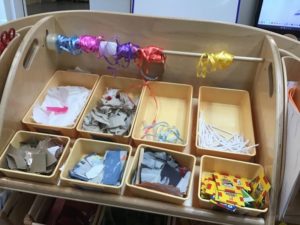 Many thanks for your donations.
Many thanks for your donations.
Junk modelling or recycled art is being creative with materials that would otherwise be discarded. Junk modelling construction gives children the freedom to build what they want with the addition of resources like tape and glue.
Modelling with recycled resources encourages higher order thinking. Children can work on their own or co-operate with others, learning to explore and share ideas. When they create something new it can build self confidence and boost self-esteem. Junk modelling is all about the learning process rather than the end product.
Here are some examples of what we have made so far this term:
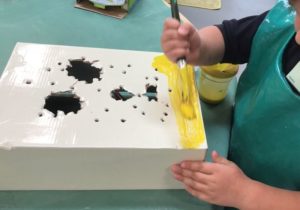
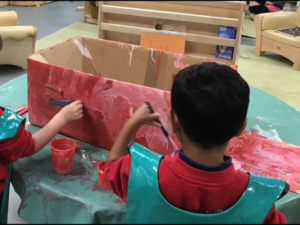


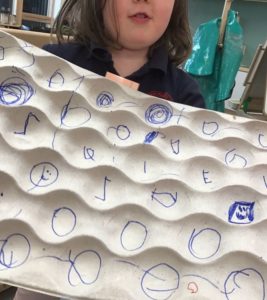
Up-cycling!
 Donated cable drums have also been up-cycled to make tables for our indoor role play areas and outdoor areas. We measured offcuts of cloth, cut them to size and stapled them to the cable drum surface.
Donated cable drums have also been up-cycled to make tables for our indoor role play areas and outdoor areas. We measured offcuts of cloth, cut them to size and stapled them to the cable drum surface.
The orchard bubble have been busy!
The orchard bubble has shown a great interest in making playdough over the last few weeks. The children have taken responsibility for their own learning by coming up with different ideas of how they want to create their playdough from colours and texture. “I want blue.”
“I want pink.”
The children had shown an interest in loose parts and wanted to include this in their playdough experience. By incorporating loose parts with playdough the children are developing their fine motor skills. They use a variety of movements such as pressing, rolling and stretching. This will help to strengthen the muscles in their hand which in turn will help them with their writing skills.
“I want to use leaves.”
“Oooohhh feathers.”
The children showed ownership over their creations and seemed to enjoy the fact that they could start again when one model was finished. They did show interest in taking them home so our next steps will be trying to create models with loose parts and clay.

“Can we take them home?”
From a very young age children benefit in all areas of their development when taking part in musicality sessions.
In Ballet the children are learning how to control their bodies through balance, good posture, listening skills, following instructions and rhythm, also finding their own space, cooperating with others and taking part in a performance.
We started of with the basic movements of dance and Ballet such as Feet Positions ——- first position (happy feet ) , parallel ——- (feet together ) and Second (feet apart).
Arm Positions ——- Bras Bas (first position of the arms ) Gateway (out in front ) Second(arms out wide ).
Moves within Ballet such as —- point lift, point close, springs in first, plies “which we called make a diamond,”
And at the end of every performance we learned who to do a bow and a courtesy.
We put it altogether and made a dance and chose music.
Ballet is an art form created by the movement of the human body. It is theatrical – performed on a stage to an audience utilising costumes, scenic design and lighting. It can tell a story or express a thought, concept or emotion. Ballet dance can be magical and exciting.
We’ve been having lots of fun being creative and exploring how to use different materials to learn how to weave. The children enjoyed choosing from a variety of colours and textures of ribbon, paper, card and wool. Weaving is a fantastic activity for young children to try and offers many benefits such as developing fine motor skills and hand eye coordination, as well as developing concentration and providing a physical experience of the spatial concepts of over and under. It is also an ideal experience to help strengthen the muscles in both hands as the dominant and non-dominant hands are used at the same time. Here are some of the different types of weaving that we tried:
“I like all the different colours of the ribbon.”
“You need to go over and under and over and under all the way to the end.”
“I’m lifting the wool  up so the ribbon can go under”
up so the ribbon can go under”
“This is quite tricky.”
“I need to push this through and catch it at the other side.”
“I like the gold ribbon best. It’s so shiny.”
“I’m getting good at this now. I’m just going to pull the needle.”
Working with Starcatchers, we developed a creative project on triangles. Children and parents brought lots of lovely triangles from home (thank you).
Child: “The triangles are all different sizes. Oh, Look at them, they are all my favourite. I made some at home, here they are.”
Then …….
…we made more at Glenwood using lots of different materials to decorate.
…we cut slots into our triangles. We tried scissors and then saws.
…we found we could make 3D shapes by connecting them together and we could make lots of different shapes.
…we took some outside and made a traffic jam with lots of cars.
…we were thinking about our community and neighbours and being ‘intergenerational’. So we made some into bunting and delivered it to our friends with a card. We wrote:
“We are thinking of you and hope our triangles make you happy”.
Parent: “I really liked the idea of the triangles and having something to work with my child at home and bring in. It made me feel more connected to the nursery at this time when we can’t come in”.